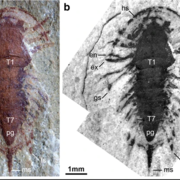
The non-trilobite arthropod (the largest phylum in the animal kingdom, which includes such familiar forms as lobsters, crabs and spiders) Sinoburius lunaris has been known for approximately three decades, but few details of its anatomy are well understood due to its rarity within the early Cambrian Chengjiang biota in Southern China, and the technical limitations for studying these fossils. In a new paper by Javier Ortega-Hernández in collaboration with Prof. Yu Liu, Yunnan University, China, researchers use microCT to show in great detail the limb anatomy of Sinoburius lunaris. The paper published in BMC Evolutionary Biology also shows a a substantial degree of antero-posterior limb differentiation, which is contrary to the traditional view that these early trilobite-like euarthropods were simple animals.
